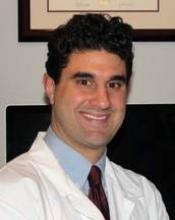FT. LAUDERDALE, FLA – Early repair – within one week – of acquired ventral septal defect in patients with myocardial infarction was associated with a significantly higher mortality rate than was later repair in a retrospective review.
Acquired ventral septal defect (VSD), a relatively rare but devastating complication of myocardial infarction, frequently leads to cardiogenic shock and death. Surgical repair is generally required, although there is a high mortality.
To identify risk factors for poor patient outcomes, a study of the Society for Thoracic Surgeons National Database was performed to characterize patients undergoing post-MI VSD surgical repair, Dr. George J. Arnaoutakis said at the annual meeting of the Society of Thoracic Surgeons.
This retrospective review identified all adults (patients greater than 18 years of age) who underwent post-MI VSD repair between 1999 and 2010. The primary outcome measure was operative mortality and patients with congenital VSD were excluded.
"This largest to date study examining post-MI VSD repair was done in part to provide a surgical benchmark for future comparisons as percutaneous closure devices emerge to treat this condition," noted Dr. Arnaoutakis of the division of cardiac surgery at Johns Hopkins University, Baltimore.
The demographics of the 2,876 patients included in the study were a mean age of 68 years; 56.5% of the patients were men; and 7.5% of patients had prior coronary artery bypass grafting (CABG) surgery. Operative characteristics included preoperative support with an intraaortic balloon pump (65%); urgent status (35%); emergent status (49.7%); and concomitant CABG (63.9%).
Timing of surgery was found to be an important predictor of risk, with 54% mortality occurring in patients who had repair less than 7 days after MI, and 18% mortality in those patients who had their surgery greater than 7 days after MI. Multivariate analysis also showed that the timing of MI with relation to VSD repair was independently associated with operative mortality.
Overall, major morbidity and mortality was high, at nearly 77%. Other surgical characteristics significantly associated with higher mortality included longer cardiopulmonary bypass time, preoperative dialysis, emergent surgery, and shock.
"Ventricular septal rupture remains a devastating complication after myocardial infarction," he said, with a shorter time interval between MI and surgical repair of the VSD, being highly associated with operative mortality, Dr Arnaoutakis summarized.
He did point out that one flaw in this study based on the STS Database was that it could not account for patients who died while waiting for VSD repair, which might influence the results. In addition the overall incidence of acquired VSD was too low to determine the effect of individual surgeon or center volume on mortality rates.
Dr. Arnaoutakis agreed with audience suggestions that given the high overall mortality rate of surgical VSD closure, perhaps consideration of the new percutaneous closure devices and the possibility of ventricular assist device support might be reasonable options.
Dr. Arnaoutakis reported having no financial conflicts. Another researcher on the project reported research support from HeartWare International Inc. and Thoratec Corp.

